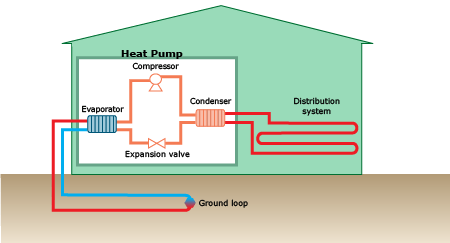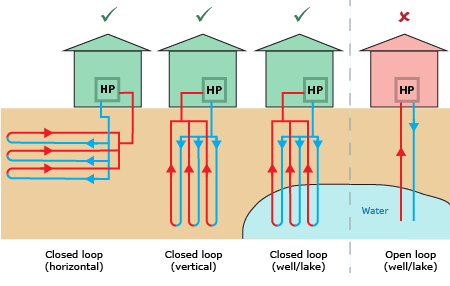A ground source heat pump makes use of the earth's constant temperature to provide heating and cooling. In addition to the heat pump, the system consists of loops of refrigerant or water buried underground called ground loops. The ground loop extracts the heat from the ground for heating or removes the heat to the ground for cooling. The heat pump transfers heat between the ground loop and the dwelling similar to a reverse cycle air-conditioner.
In addition to heating and cooling, BASIX also allows the heat pump either to provide hot water pre-heating through a desuperheater, or to function as a primary system to deliver hot water at the required temperature.

Diagram of a ground-source heat pump system for heating and cooling
Some ground source heat pump systems have the ground loop and refrigerant loop circulating as two separate circuits. Water sourced systems refer to systems that have water circulating in the ground loop. For systems that utilize refrigerants in both ground and refrigerant loops, the water sourced option can be selected in the BASIX tool.
Direct exchange systems consist of only a single loop of refrigerant circulated continuously from the heat pump through copper loops buried underground.
The refrigerant or water in the above systems is circulated internally. These systems are therefore called closed loop systems. Less common are open loop systems where water from a well or lake is drawn directly to the heat pump.

Ground loop installation options available in BASIX
Only closed loop systems are available in BASIX for single detached houses. Check with the BASIX helpdesk if the ground source heat pump system consists of open loops or operates for a multi dwelling development. They will be able to help you determine if you are eligible for an alternative assessment.
BASIX assesses the energy for ground source heat pumps based on:
- For cooling, the Energy Efficiency Ratio (EER);
- For heating, the Coefficient of Performance (COP);
- Whether it is used in hydronic floor heating and/or cooling;
- Whether it is connected to a desuperheater for hot water pre-heating;
- Whether it is connected as a primary hot water system – no other hot water systems must be installed.
The EER and COP should be rated in accordance to the relevant industry standards (such as AS/NZS 3823.1.3 or ISO 13256-2). The rated EER and COP values need to be expressed in units such as W/W or kW/kW (and not Btuh/W) for BASIX inputs.
In order for the certifier to ensure that commitments of BASIX certificate relating to ground source heat pump are met, a design engineer or installer needs to issue a verification certificate after the heat pump is installed and commissioned on site. The certificate lists the specifications of the ground source heat pump installed in the dwelling.
The certificate must bear the logo and contact details of the issuing company. It must also be attached with the BASIX certificate corresponding to the same address in the application for an occupation certificate.
Find out more about what a sample verification certificate should look like.